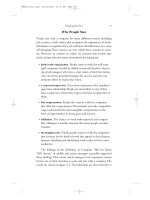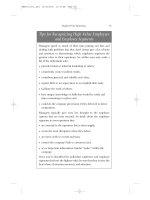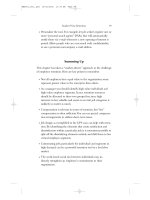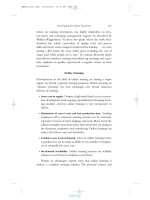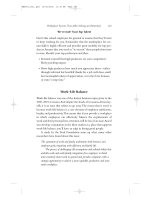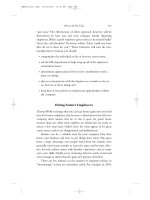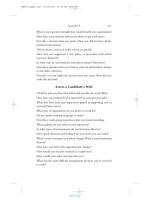Hiring and Keeping the Best People 17
Bạn đang xem bản rút gọn của tài liệu. Xem và tải ngay bản đầy đủ của tài liệu tại đây (112.33 KB, 8 trang )
Focusing on Culture
Workplace Factors That
Affect Hiring
and Retention
6
Key Topics Covered in This Chapter
•
Company culture, and how it can attract or
repel the kinds of people you want to hire
and retain
•
Employee burnout, and how to minimize
or avoid it
•
Work-life balance, and how to make it work
for both employees and the company
HBE001_ch6_.qxd 10/02/2002 11:36 AM Page 115
H
iring discussions with potential recruits
almost always focus on the specifics of the job, the
reporting relationships, career possibilities, and com-
pensation and benefits. Each of these is important to job applicants.
But the climate of the workplace may be equally important in the
applicant’s decision to take the job—or to stay for any length of time
thereafter.
Some companies have reputations as great places to work. For-
tune identifies the best of these companies each year in its list of the
“100 Best Companies to Work For.” Certain companies, such as
stockbroker Edward Jones, Container Store, SAS Institute, Plante &
Moran, and Frank Russell are consistently near the top of the list.
Working Mother produces a similar “top 100” list from the perspective
of women with children. The reputations of companies that make
these lists undoubtedly make them more attractive to job applicants
and current employees.
In this chapter, we examine three workplace factors that play an
important role in hiring and retention: company culture, employee
burnout, and work-life balance.
Consider Your Culture
As one of the factors that determines the attractiveness of an organ-
ization to qualified potential recruits and to current employees,
culture matters. If a culture is excessively relaxed, for example, the
company may have trouble attracting and retaining hard-core pro-
HBE001_ch6_.qxd 10/02/2002 11:36 AM Page 116
fessionals; they may find the workplace insufficiently “serious” and
detrimental to their long-term careers. If the culture is too formal
and straight-laced, young and creative types are likely to feel
uncomfortable and out of place. If it’s unwelcoming to women and
minorities, talented individuals in those communities will look
for careers elsewhere. And none of these groups will be keen on
working for a company if its culture is dominated by conflict, turf
wars, dysfunctional senior management, or excessive hierarchical
privilege.
How is your workplace culture perceived? As a first step in
improving culture, ask employees these two questions:
1. Are there any important gaps between the kind of atmosphere
you would like to work in and the atmosphere that currently
characterizes our group? If so, what are they?
2. What measures would help improve our work culture and/or
help close gaps between what we want or need and what
exists?
There are many ways to close gaps between the current culture
of your organization and the one you need to attract and retain great
people. Here are just a few sample scenarios:
Scenario 1:
Your department’s young, high-energy employees
want a more informal, fun, and hard-driving culture.They
find the current culture too formal and rigid. In this case, you
could try the following:
•
Relax the dress code.
•
Permit flexible schedules that let employees work long hours
during high-pressure projects and more reasonable hours at
other times.
•
Install a ping-pong or foosball table to allow employees to
burn off energy.
•
Take your team to a local park for a volleyball game and
picnic lunch.
•
Start a tradition whereby you have a party at the end of
challenging projects.
Workplace Factors That Affect Hiring and Retention 117
HBE001_ch6_.qxd 10/02/2002 11:36 AM Page 117
TEAMFLY
Team-Fly
®
•
Bring in stand-up comic videos (nothing too extreme,
though!) and play them in a conference room during lunch.
Scenario 2:
Your department has many employees with
young families.They don’t like the current separation
between their lives at work and their lives at home. Consider
these ideas:
•
Institute regular family picnics—and invite people to bring
their pets, too! (Many people consider their companion
animals as members of the family.)
•
During informal conversations, ask employees about their
families—and show a genuine interest in what they say.
•
Let employees bring their children to work occasionally to
celebrate special occasions.
•
Facilitate work from home during part of the week, or pro-
vide flextime or other arrangements to reduce family stress.
•
Let employees go home early on their birthday or their
wedding anniversary, or to attend parent/teacher conferences
or important school events.
Scenario 3:
Your group consists of researchers who want
enough privacy and quiet to do the concentrated thinking
and writing required by their jobs.Try these ideas:
•
If your department has cubicles instead of offices with doors,
invest in “white-noise” machines to drown out distracting
sounds.
•
Allow employees to work from home during times when
they’re embroiled in especially intense projects.
•
Keep the frequency and length of meetings to a minimum.
But don’t allow people to become too isolated. Even if they
must work quietly and alone you can create a team spirit by
means such as these:
•
Periodically reward the group with free passes to the theater,
museum exhibits, the ballet, and other cultural events.
•
Start up a book or film discussion group, which could meet
once a month during lunch.
118 Hiring and Keeping the Best People
HBE001_ch6_.qxd 10/02/2002 11:36 AM Page 118
Clearly, fine-tuning your culture doesn’t have to be difficult or
expensive. All it takes to develop an appropriate culture is a wil-
lingness to observe and listen, a little creativity, and openness to new
ideas. But remember that managers must be visible symbols of the
culture they aim to promote. Employees look at what top manage-
ment does. If management says “Let’s be casual” but still wears suits
every day, anyone who aspires to being at the top will keep on wear-
ing a suit. If management says “We care about our people” but
focuses only on cost controls and dumps long-term employees at the
first whiff of slowing revenues, no one will take their statements seri-
ously.That said, by attending to your culture in these ways and really
working to change it for the better, you can make your organization
more attractive to the people you’d like to hire—and boost your
retention rate.
Employee Burnout
Burnout is work exhaustion.It is sometimes self-induced,but in many
other cases is a result of the workplace culture. Burnout typically
manifests itself through lower job satisfaction, less commitment to
the organization, and heightened intention to “do something differ-
ent.” In some cases, you will also see these warning signs:
•
reduced self-esteem (when there’s just too much to be done,
some people blame themselves)
•
a decline in feelings of competence and achievement
•
a detached or negative approach to colleagues, customers, and
clients
Burnout generally results from long-term involvement in situa-
tions that have many negative attributes, such as:
•
work overload
•
conflicting demands (e.g.,“Think big and be creative—but
don’t make any mistakes”)
•
unclear objectives
Workplace Factors That Affect Hiring and Retention 119
HBE001_ch6_.qxd 10/02/2002 11:36 AM Page 119
